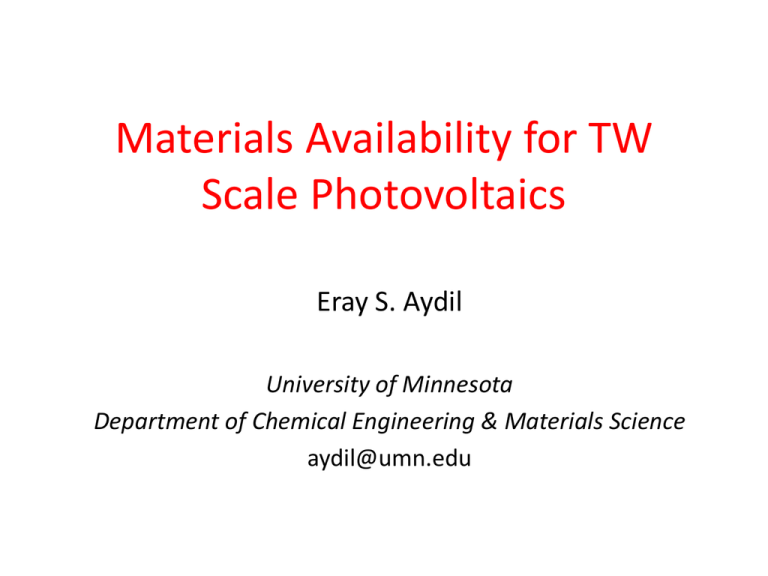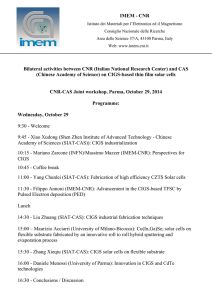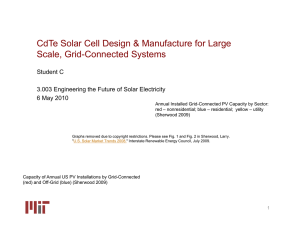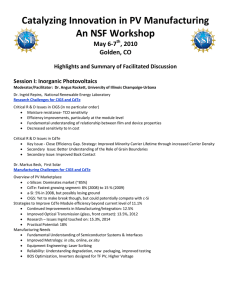Materials Availability for TW Scale Photovoltaics Eray S. Aydil University of Minnesota
advertisement

Materials Availability for TW Scale Photovoltaics Eray S. Aydil University of Minnesota Department of Chemical Engineering & Materials Science aydil@umn.edu Survey of audience a) Current thin film technologies, CdTe, CIGS & thin film Si will grow at rates that will accumulate to ~10 TW by sometime between 2050-2100. a) Above statement can not be true. We will need other (new) materials and technologies other than or in addition to CdTe, CIGS & thin film Si to achieve ~10 TW by sometime between 2050-2100. One can defend any one of these statements with seemingly reasonable assumptions. References addressing the materials availability issue • Fthenakis “Sustainability of photovoltaics: the case for thin-film solar cells.” Renewable and Sustainable Energy Reviews 23, 2746 (2009). • Wadia, Alivisatos & Kammen, “Materials availability expands the opportunity for large scale photovoltaics development.” Environ. Sci. Technol. 43, 2072 (2009). • Zweibel, “The Terrawatt challenge for thin film PV: A work in progress” NREL Report (2006). • Andersson, “Materials availability for large-scale thinfilm photovoltaics,”Prog. Photovoltaics 8, 61 (2000). One limitation is abundance of elements If rare also difficult to recover and therefore expensive. There may not be enough of it to reach ~10 TW Wikipedia.org Another limitation could be the price September 2008 - “SMG filed an IPO to raise $55 million on the American Stock Exchange – plans to use the money it raises to stockpile indium in the hope of selling it for higher prices in the future.” If rare others may want it too. Supply & demand difficult to predict www.greentechmedia.com Te availability may limit the growth rate of CdTe PV • • • • Te is a byproduct of Cu production Te production rate tied to Cu production ~ 30-40% of available Te is recovered Cu production is uncertain Fthenakis, Renewable & Sustainable Energy Reviews. Sci. Technol. 13, 2746 (2009). Projected growth rate limits for CdTe solar cells based on Te Availability “Optimistic” “Likely” “Conservative” • • • • Cu production peaks 2025 or 2060 ~ 80% of available Te is recovered CdTe thickness down to 1 µm, efficiency up to 14% All scenarios include secondary recovery Fthenakis, Renewable & Sustainable Energy Reviews. Sci. Technol. 13, 2746 (2009). CdTe PV Cumulative Power (GW) Projected growth rate limits for CdTe solar cells based on Te Availability 2000 1500 1000 500 0 2010 2030 2050 2070 2090 Year • • • Cu production grows to 2060 and remains constant at 53 Mt/year ~ 33% of available Te is recovered CdTe thickness 2 µm, efficiency up to 15 % In availability may limit the growth rate of CIGS PV • In is a byproduct of Zn production • Te production rate tied to Zn production • ~ 70-80 % of available In is recovered Fthenakis, Renewable & Sustainable Energy Reviews. Sci. Technol. 13, 2746 (2009). CIGS PV Cumulative Power (GW) Projected growth rate limits for CIGS solar cells based on In Availability 1500 1000 500 0 2010 2030 2050 2070 2090 Year • • • Zn production grows to 2060 and remains constant at 11 Mt/year ~ 80% of available In is recovered CdTe thickness 1.6 µm, efficiency up to 17 % Annual electricity production potential of common inorganic semiconductors Wadia, Alivisatos & Kammen, Environ. Sci. Technol. 43, 2072 (2009). Raw materials cost of common inorganic semiconductors Wadia, Alivisatos & Kammen, Environ. Sci. Technol. 43, 2072 (2009). Which materials have extraction costs lower than Si and electricity producing potential greater than Si? Wadia, Alivisatos & Kammen, Environ. Sci. Technol. 43, 2072 (2009). CZTS Solar Cells by Sulfurization of a stack of evaporated Zn/Sn/Cu films Cu Sn Zn Mo H2S/N2 500 oC Cu2ZnSnS4 Mo Jsc = 6 mA/cm2 Voc= 400 mV FF = 28% η = 0.66% Katagiri et al. Sol Energ. Mater. Sol. C. , 49, 407 (1997). CZTS Solar Cells by Sulfurization of co-sputtered Cu, SnS and ZnS film ZnS SnS Cu Mo H2S/N2 580 oC Cu2ZnSnS4 Mo Jsc = 17.9 mA/cm2 Voc= 610 mV FF = 62% η = 6.77% Katagiri et al. Applied Physics Express, 1, 041201 (2008). Evolution of CZTS power conversion efficiency ~ 600 articles keywords = CIGS and solar ~ 1300 articles keywords = CdTe and solar ~ 6800 articles keywords = organic and solar ~ 7100 articles keywords = a-Si and solar ~ 50 articles keywords = CZTS and solar Cu2ZnSnS4 (CZTS) Raman spectra 337 cm-1 CZTS CTS • • • Element Cu2ZnSnS4 Cu 2 1.95±0.03 Zn 1 1.01±0.03 Sn 1 1.01±0.02 S 4 4.02±0.04 Synthesized 2-10 nm CZTS nanocrystals from metal dithiocarbamates Stable colloidal dispersions in organic solvents HRTEM, XRD, Raman, EPMA, optical absorption consistent with CZTS A. Khare, D. J. Norris, and E. S. Aydil, unnpublished, (2010). NCs by EPMA Solar cells with films cast from CZTS colloidal nanocrystal solutions Riha, Parkinson & Prieto, JACS 131, 1 (2009); Guo, Hillhouse & Agrawal, JACS 131, 11672 (2009); Steinhagen, Panthani, Akhavan, Goodfellow, Koo & Korgel, JACS 131, 12554 (2009); High-Efficiency Solar Cell with Earth-Abundant Liquid-Processed Absorber Todorov, Reuter, Mitzi, Advanced Materials 22, 1 (2010). Cu2O-ZnO heterojunction solar cells Jeong & Aydil, J. Cryst. Growth 311, 4188 (2009). Cu2O-ZnO heterojunction solar cells efficiencies (~1-2%) and Voc (~0.1-0.4 V) so far has been low Interface quality and defects implicated for poor performance 65 nm ZnO 130 nm ZnO 200 nm ZnO 10 nm TiO2 + 65 nm ZnO 1.2 1.0 Voc (V) 0.8 0.6 0.4 0.2 0.0 0 50 100 150 200 Temperature (K) Jeong & Aydil, unpublished. 250 300 Summary a) Current thin film technologies, CdTe, CIGS & thin film Si may grow at rates that will accumulate to ~10 TW by sometime between 2050-2100. a) We will need other (new) materials and technologies in addition to CdTe, CIGS & thin film Si to achieve ~10 TW by sometime between 20502100.


